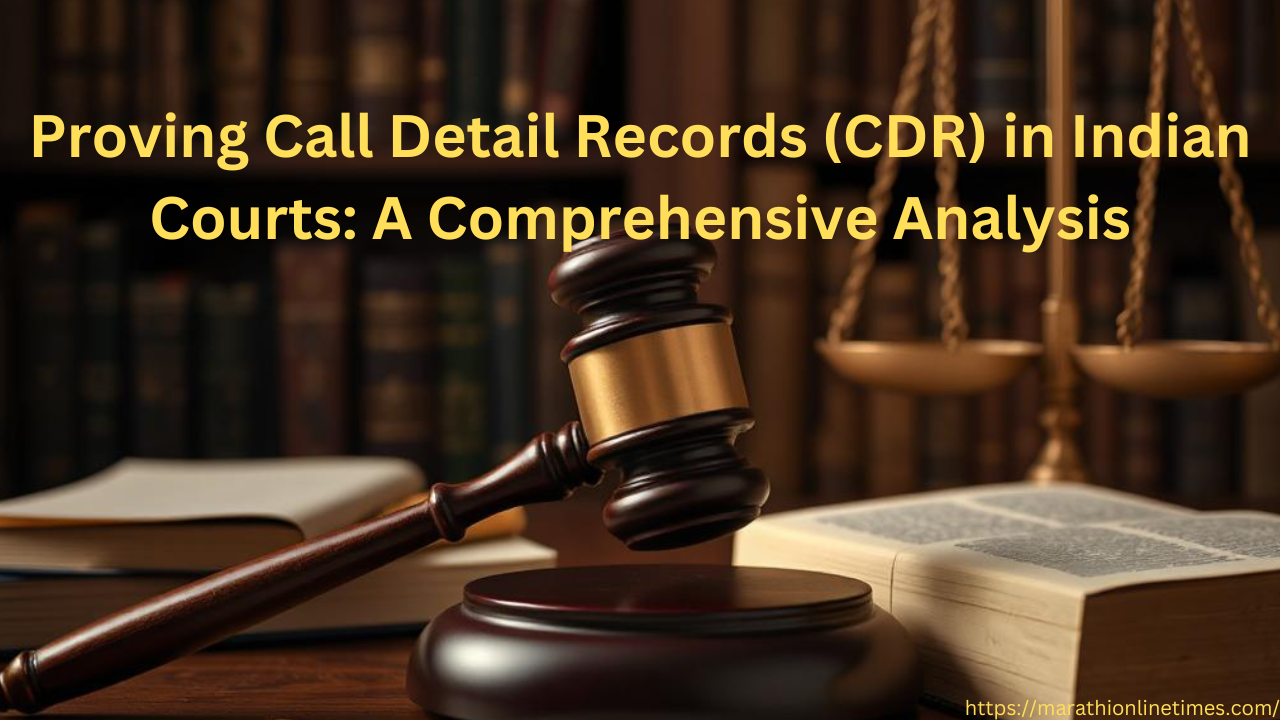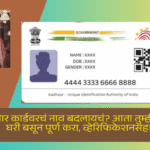Proving Call Detail Records (CDR) in Indian Courts: A Comprehensive Analysis
1. Introduction
Call Detail Records (CDRs) have emerged as critical pieces of evidence in a wide spectrum of legal proceedings within India, spanning criminal investigations, civil disputes, and regulatory matters. These records, generated and maintained by telecommunication service providers, offer a detailed log of communication activities, including the originating and terminating numbers, the date, time, and duration of calls, as well as the location of the devices involved 1. Their ability to establish communication patterns, corroborate witness testimonies, and potentially place individuals at specific locations and times makes them invaluable in modern legal contexts 1. As digital communication becomes increasingly prevalent, the reliance on electronic evidence such as CDRs is only set to grow, underscoring the necessity for a clear and well-defined legal framework governing their admissibility and proof in Indian courts. This report aims to provide a comprehensive analysis of the legal framework and procedures involved in proving CDRs in Indian courts, addressing the essential legal requirements, necessary documentation, relevant legal provisions, landmark case precedents, inherent challenges, and recommended best practices.
2. Legal Framework for Admissibility of Electronic Evidence in India
The admissibility of electronic evidence in India is primarily governed by the Indian Evidence Act, 1872 (IEA), as amended by the Information Technology Act, 2000 (IT Act) 2. Recognizing the evolving nature of evidence in the digital age, the IEA underwent significant amendments to accommodate electronic records. Notably, Section 3 of the IEA was amended to include “electronic records” within the definition of “documents,” thereby bringing them under the purview of documentary evidence 2. While Section 59 of the IEA states that all facts, except the contents of documents or electronic records, may be proved by oral evidence, Sections 65A and 65B lay down a special procedure for proving the contents of electronic records 3. This legislative framework acknowledges the unique characteristics of electronic evidence and establishes specific conditions for its admissibility.

The Information Technology Act, 2000, plays a crucial role by providing the definition of “electronic record” and establishing the legal framework for electronic transactions and evidence 1. This Act, which aligns with the United Nations Commission on International Trade Law (UNCITRAL) Model Law on Electronic Commerce, provides the necessary foundational definitions that enable the Evidence Act to effectively govern the admissibility of digital forms of evidence 2.
Within the Indian Evidence Act, Section 65B stands as the cornerstone for the admissibility of electronic records, including CDRs 1. This section outlines specific conditions under which information contained in an electronic record can be admitted as evidence. Section 65B(1) states that any information contained in an electronic record that is printed on paper, stored, recorded, or copied in optical or magnetic media produced by a computer (referred to as computer output) shall be deemed to be a document, provided the conditions specified in the section are met 4. These conditions, detailed in Section 65B(2), include requirements such as the computer having been in regular use during the relevant period, the information having been regularly fed into the computer in the ordinary course of activities, and the computer having been operating properly or, if not, that the non-operation did not affect the accuracy of the content 5. Significantly, Section 65B(4) mandates the requirement of a certificate for the admissibility of electronic records when presented as secondary evidence 1. This certificate, signed by a person occupying a responsible official position in relation to the operation of the relevant device or the management of the relevant activities, must identify the electronic record, describe the manner of its production, and provide necessary particulars of the device involved to demonstrate its reliability 1. The legal position, as affirmed by numerous Supreme Court judgments, is that Sections 65A and 65B constitute a complete code for the admissibility of electronic evidence, rendering other sections like 62 and 65 irrelevant in this context 5.
3. Methods and Procedures for Proving CDRs in Indian Courts
Proving CDRs in Indian courts involves a multi-faceted approach designed to ensure their legal admissibility and establish their authenticity and integrity. The initial step involves the legal acquisition of these records, which typically necessitates a court order or a formal request from an authorized law enforcement agency 1. This authority is derived from the provisions of the Indian Telegraph Act, 1885, and the Information Technology Act, 2000 1. The request for CDRs must be initiated by an officer of a specific rank, generally not below the Superintendent of Police, and must be sanctioned by a competent authority, underscoring the importance of due process in obtaining this sensitive information 1.
Once legally obtained, ensuring the authenticity of the CDRs is paramount for their admissibility as evidence 1. The primary method for establishing authenticity involves the submission of a certificate under Section 65B of the Indian Evidence Act 1. Ideally, the telecom service provider should also digitally sign the CDRs to further enhance their authenticity 1. The legal emphasis on authentication stems from the inherent susceptibility of electronic records to tampering, necessitating robust procedures to verify their genuineness.
Presenting witness testimony is another crucial aspect of proving CDRs. Witnesses who can provide insights into the procedures followed for obtaining, storing, and retrieving the CDRs are essential 1. This may include the law enforcement officers who requested the records and employees of the telecom company responsible for their production 1. The nodal officer from the telecom company, who possesses access to the server data, is typically the appropriate person to provide printouts of the CDRs in the specified format along with the requisite Section 65B certificate 1. These witnesses must be available for cross-examination by the opposing party, ensuring transparency and allowing for scrutiny of the evidence 1.
In terms of documentation, either the original CDRs or certified copies must be submitted to the court, accompanied by the crucial Section 65B certificate 1. While the best evidence rule generally favors the production of original documents, Section 65B provides a specific mechanism for the admissibility of secondary electronic evidence, acknowledging the practical challenges of producing original electronic records stored on servers and other digital infrastructure.
Warrant Trial by Magistrate on Police Report
To further strengthen the evidentiary value of CDRs, it is advisable to corroborate them with additional evidence 1. This may include witness statements, forensic evidence, or other relevant documentary evidence. For instance, a Subscriber Details Report (SDR) can be used to link incriminating cell phone numbers to specific individuals 1. Furthermore, the tower location details found within the CDRs can potentially establish the presence of individuals at relevant locations during specific timeframes 1. The combination of different types of evidence creates a more compelling and reliable narrative for the court.
Finally, maintaining a clear chain of custody for the CDRs is essential to demonstrate that they have not been tampered with from the time of acquisition until their presentation in court 1. This involves meticulously documenting every step in the handling of the evidence, including who accessed it, when, and for what purpose. In complex cases, technical experts may be engaged to verify the integrity and authenticity of the data, providing an additional layer of assurance to the court 1.

4. Legal Requirements and Necessary Documentation for CDR Admissibility
The admissibility of CDRs as electronic evidence in Indian courts hinges on strict adherence to specific legal requirements and the provision of necessary documentation. The most critical requirement, as consistently emphasized by legal provisions and judicial pronouncements, is the submission of a certificate under Section 65B(4) of the Indian Evidence Act 1. This certificate serves as the primary means of authenticating electronic records and is considered a condition precedent for their admissibility when presented as secondary evidence.
The Section 65B certificate must contain specific information to ensure its validity. It must state that the CDRs were produced by a computer during its regular use and that the information contained therein was regularly fed into the computer in the ordinary course of business 1. The certificate should also provide detailed information about the computer system involved in generating the CDRs, the methodology employed for data production, and the specific process followed in producing the records to establish their reliability 1. Furthermore, the certificate must clearly identify the specific electronic record being certified, describe the manner in which it was produced, and include relevant particulars of any device involved in the production process 6. It should also aim to demonstrate that the computer was functioning properly or, if not, that any malfunction did not impact the accuracy of the data 5. Crucially, the certificate must be executed and signed by a person holding a responsible position in relation to the operation of the relevant device or the management of the relevant activities, such as the nodal officer of the telecom company 1. The person signing the certificate must also affirm that the matters stated therein are true to the best of their knowledge and belief 4.
Beyond the Section 65B certificate, other essential documentation includes the court order or authorized request under which the CDRs were legally obtained 1. Documentation demonstrating the authorization of the requesting officer is also necessary 1. To establish the integrity of the evidence, detailed chain of custody records must be maintained, tracing the handling of the CDRs from acquisition to presentation in court 1. This includes records of who accessed the data, the dates and times of access, and the purpose of each access. In some cases, an affidavit from the nodal officer or a relevant employee of the telecom company may be required to further authenticate the CDRs and the accompanying Section 65B certificate. If a Subscriber Details Report (SDR) is used in conjunction with the CDRs to link phone numbers to individuals, the SDR and its authentication documentation are also necessary for its admissibility 1.
Requirement
Description
Source
Statement of Production
Must state that the CDRs were produced by a computer during regular use.
1
Information Derivation
Should confirm that the information is derived from what was fed into the computer in the usual course of activities.
1
Details of Computer System
Must contain details about the computer system used to generate the CDRs.
1
Method of Data Production
Should describe the method by which the data was produced.
1
Process of Record Production
Must detail the process of producing the records to establish reliability.
1
Identification of Electronic Record
The certificate must clearly identify the specific CDRs being certified.
6
Description of Production Manner
Should describe the manner in which the electronic record was produced.
6
Particulars of Device Involved
Give appropriate particulars of any device involved in the production of the CDRs.
6
Showing Proper Functioning
Aim to show that the electronic record was produced by a computer that was operating properly or, if not, that the non-operation did not affect the accuracy of the content.
5
Signed by Responsible Person
Must be executed/signed by a person occupying a responsible position in relation to the device (e.g., nodal officer of the telecom company).
1
Statement to Best of Knowledge and Belief
Certification of matters are to be stated to the best of the knowledge and belief of the person signing the certificate i.e., the officer in charge of the operation or management of the related activities.
4

5. Analysis of Relevant Legal Provisions, Acts, and Case Laws
Several legal provisions, acts, and landmark case laws are pertinent to the process of proving CDRs in Indian courts. The Indian Telegraph Act, 1885, provides the legal framework for telecommunication services in India, including the maintenance of call records by telecom companies and the authority for designated agencies to request these records under specific circumstances 1. The Information Technology Act, 2000, as previously discussed, defines “electronic record” and provides the overarching legal structure for the admissibility of electronic evidence 1. Sections 65A and 65B of the Indian Evidence Act, 1872, are central to this discussion, laying down the procedural and substantive requirements for the admissibility of electronic records 3.
Among the case laws, Anvar P.V. v. P.K. Basheer (2014) 10 SCC 473 stands as a seminal judgment that significantly shaped the legal landscape concerning the admissibility of electronic evidence 4. In this case, the Supreme Court unequivocally held that a certificate under Section 65B(4) of the IEA is mandatory for the admissibility of electronic records produced as secondary evidence. This ruling overruled the earlier interpretation in State (NCT of Delhi) v. Navjot Sandhu alias Afsan Guru (the Parliament Attacks case) regarding the applicability of Sections 63 and 65 of the IEA to electronic evidence. The Court clarified that Sections 65A and 65B form a self-contained code for the admissibility of information contained in electronic records. This judgment firmly established the necessity of the Section 65B certificate for the admissibility of CDRs when presented as secondary evidence, settling previous ambiguities and providing a clear legal precedent.
Subsequently, the Supreme Court in Arjun Pandit Rao v. Kailash Kushanrao (2020) further solidified the mandatory nature of the Section 65B certificate as a condition precedent for the admissibility of electronic evidence 8. While reiterating the importance of the certificate, the Court clarified that it is not required if the original electronic record is produced by the owner of the device stepping into the witness box and proving its authenticity. This judgment also explicitly overruled the ‘clarification’ provided in Shafhi Mohammed v. State of Himachal Pradesh and the decision in K. Ramajyam, which had introduced some flexibility to the mandatory requirement of the certificate. Furthermore, in Arjun Pandit Rao, the Supreme Court issued general directions to cellular companies and internet service providers to maintain CDRs and other relevant records in a segregated and secure manner for specified periods if such records are seized during an investigation. This directive aims to facilitate the availability of such evidence for concerned parties during the trial process.
The case of Shafhi Mohammad v. State of Himachal Pradesh (2018) 2 SCC 801 initially held that the requirement of a Section 65B(4) certificate is procedural and could be relaxed by the court in the interest of justice, particularly when the party seeking to adduce the evidence was not in possession of the device from which the electronic record was generated 4. However, as mentioned earlier, this view was later overruled by the Supreme Court in Arjun Pandit Rao, which emphasized the strict adherence to the statutory requirement of the certificate for secondary electronic evidence. Similarly, Tomaso Bruno and Anr. v. State of Uttar Pradesh (2015) 7 SCC 178, which also dealt with the admissibility of electronic evidence without a proper certificate, was also overruled by Arjun Pandit Rao, reinforcing the mandatory nature of the Section 65B certificate 5.
In contrast, the case of Vikram v. State of Punjab (2017) 8 SCC 518 held that tape-recorded conversations could be considered primary evidence and might not necessitate a Section 65B certificate if the original recording device is produced and its authenticity is duly proven 4. This highlights the distinction between primary and secondary electronic evidence and its implications for the applicability of the Section 65B requirement. Finally, Syed Asifuddin V/S State of Andhra Pradesh (2006) provided a definition of “computer” under the IT Act, encompassing a wide range of electronic, magnetic, or optical devices used for storing and processing information 3. This definition is crucial for understanding the scope of electronic records covered by Section 65B of the IEA.
Notes on “Summary Trial” Practice & Procedure in India
Case Name
Year
Key Holding
Relevance to CDR Admissibility
Anvar P.V. v. P.K. Basheer
2014
Section 65B(4) certificate is mandatory for admissibility of electronic records produced as secondary evidence. Sections 65A and 65B form a complete code.
Establishes the fundamental requirement of the Section 65B certificate for CDRs when presented as secondary evidence. Overruled previous interpretations.
Arjun Pandit Rao v. Kailash Kushanrao
2020
Reaffirmed the mandatory nature of the certificate. Clarified that the certificate is not needed for original electronic records produced by the owner. Overruled Shafhi Mohammed and Tomaso Bruno.
Solidified the Anvar P.V. ruling and provided crucial clarifications regarding original records and the overruling of earlier conflicting judgments. Also directed service providers to maintain records. Directly impacts the procedure for admitting CDRs depending on whether they are presented as original or secondary evidence.
Shafhi Mohammad v. State of Himachal Pradesh
2018
Initially held that the certificate requirement is procedural and can be relaxed.
While later overruled, it highlights a past interpretation and the subsequent emphasis on strict compliance with Section 65B.
6. Challenges and Potential Issues in Proving CDR Authenticity and Integrity
Despite the established legal framework, proving the authenticity and integrity of CDRs in Indian courts can present several challenges. One of the primary concerns is the inherent vulnerability of electronic records to tampering 6. Unlike traditional physical documents, digital data can be easily altered or manipulated without leaving readily apparent traces, raising doubts about the reliability of CDRs as evidence. This necessitates stringent authentication and integrity checks to ensure that the records presented in court are genuine and have not been compromised in any way.
Another significant challenge lies in the technical complexity associated with CDRs. Understanding the intricate processes involved in their generation, storage, and retrieval often requires specialized technical knowledge that may not be readily available to non-technical individuals such as judges and lawyers 3. This can make it difficult for the court to fully comprehend the reliability of the evidence and to effectively assess any claims of tampering or inaccuracy. The technical nature of electronic evidence underscores the need for judges and legal professionals to possess a foundational understanding of computer operations and digital forensics to facilitate informed decision-making 3.
Maintaining an unbroken and well-documented chain of custody for electronic evidence like CDRs can also be a complex undertaking, particularly when multiple parties are involved in their handling 1. Any gaps or inconsistencies in the chain of custody can raise legitimate concerns about the integrity of the CDRs and potentially render them inadmissible in court. Establishing and meticulously documenting each step in the lifecycle
Proving Call Detail Records (CDR) in Indian Courts: A Comprehensive Analysis
![]()










